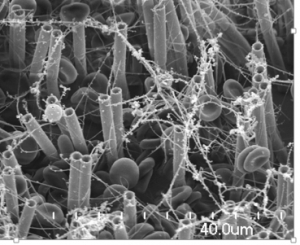Project 2: Force Platform
The history of magnetic technologies in biology dates back to the seminal paper by Crick in 1949 (Crick and Hughes 1949). There are many techniques available for applying and measuring forces in biological systems. Magnetics offers advantages in providing forces in the NanoNewton range, being compatible with bead functionalization technologies, low heating or non-specific interaction with the specimen, useful for single molecule, cell mechanics, tissues level and rheological applications. CISMM develops instrumentation for performing force measurements on single specimens and in high throughput settings.
Viscometric Biosensing Platform: We have developed a novel technique for measuring the time dependent elastic properties of microliter quantities of biofluids using an array of magnetically actuated surface attached posts (ASAP).  Target applications of ASAP include blood clot diagnostic and mucus rheology studies. The image to the right is an SEM micrograph of a blood clot formed on our ASAP posts.
Target applications of ASAP include blood clot diagnostic and mucus rheology studies. The image to the right is an SEM micrograph of a blood clot formed on our ASAP posts.
3DFM: Three Dimensional Force Microscope The 3DFM has been designed to offer nanoNewton forces, to be capable of applying forces in every direction, to have rapid response of over 3kHz and to be compatible with high numerical aperture microscopy.
MHTS: Magnetic High Throughput System We have a prototype 16 well system that is being developed for a 96 well plate geometry to allow a wide range of studies, including cell mechanics, thromboses, mucus rheology, tissue scaffold properties and drug delivery, all with 96 specimens at a time.
Permanent Magnet System. Many mechanotransduction assays now require millions of cells, and so reproducible, quantified forces need to be applied over large areas of a cell culture dish. We address this problem with our rotating permanent magnet system.
Poles and Particles:
We fabricate, functionalize and apply magnetic nanoparticles and rods that are not available commercially. They are applied to single molecule, cell mechanics and drug delivery applications. We design and simulate pole geometries for our magnetic system for properties such as field uniformity and large effective areas of useable force.